Black Friday kicks off a shopping season that lasts through Christmas each year, with online retailers vying for the profitable attention of consumers. With spending expected to rise by 47% this year, competition will be fierce.
SEO can make a significant ecommerce contribution; some final tweaks can make the difference between rising to the top of results and languishing at the bottom of page one.
The holiday season begins in earnest for ecommerce companies with the Black Friday weekend, bookended by Black Friday (November 24) and Cyber Monday (November 27).
Black Friday (the day retailers traditionally go ‘into the black’ due to the bumper sales) follows Thanksgiving in the US and kicks off a spending spree that typically continues through the Christmas period. The digital revolution has facilitated huge growth in spending worldwide, even spawning the online-focused Cyber Monday counterpart to satiate consumers’ desire to pick up a bargain.
Although dwarfed by China’s equivalent, known as ‘Singles Day’, which recently posted $12 billion in sales on Alibaba alone within just 2 hours, Black Friday holds particular significance for retailers in the US and beyond.
For context, the following statistics should paint a clear picture of the importance of this period for online stores:
- 2017 spending is predicted to rise by 47% over the same period in 2016
- Shoppers in the US spent $3.39 billion on Cyber Monday last year and $3.34 billion on Black Friday
- The Black Friday week brought sales of £6.5 billion in the UK in 2016
- The average American consumer will spend $745 over the Black Friday weekend
- Target sold 3,200 TVs per minute during the first hour of Black Friday last year.
Brands have been planning for the holidays for a long time already, so the focus will now turn to any last-minute changes that can help tempt consumers to their site and provide a seamless transaction experience when they get there.
SEO is quite rightly considered a long-term investment and strategies take time to come into effect, but some fine-tuning can still reap dividends in the immediate short term.
The tips below are intended to give ecommerce sites an SEO performance boost – just in time for the holiday period.
Focus on keyword groups with a high ROI
All brands are aiming to maximize revenues over the holidays, which leads to an increase in activity as their marketing strategies kick into action.
Search demand patterns change too, as consumers seek inspiration across a range of digital media.
This opens opens up new opportunities; search results are affected by these forces and they change in response to the surrounding stimuli. Intelligent targeting of the right queries at the right moments can see brands move into top positions and capitalize on demand peaks.
Historical data from Google Trends or Keyword Planner can highlight the types of queries that tend to increase around this time of year. Typically, modifiers including ‘best’, ‘gift’, ‘deals’, or ‘cheap’ will be popular with shoppers on the lookout for the right present.
There’s nothing revolutionary about that, but adding these terms to basic SEO elements like internal links, title tags and meta descriptions can make all the difference.
Our guide to advanced keyword research is a great place to start this process, as it helps marketers to isolate short-term opportunities and strategize accordingly.
Use existing landing pages for high-volume terms
It helps if you are using an authoritative page to target profitable queries at the most competitive time of year. With only a couple of weeks until Black Friday, it would be a pretty tall order to launch a brand new page and rank in positions 1-3 for the most important terms,
And yet, many brands do exactly this every year. Rather than having one static Black Friday page and another for Cyber Monday that can be updated every year, they launch a new page every time the holidays roll round.
After all, the trend is predictable; we know searches for [black friday] are about to take off:
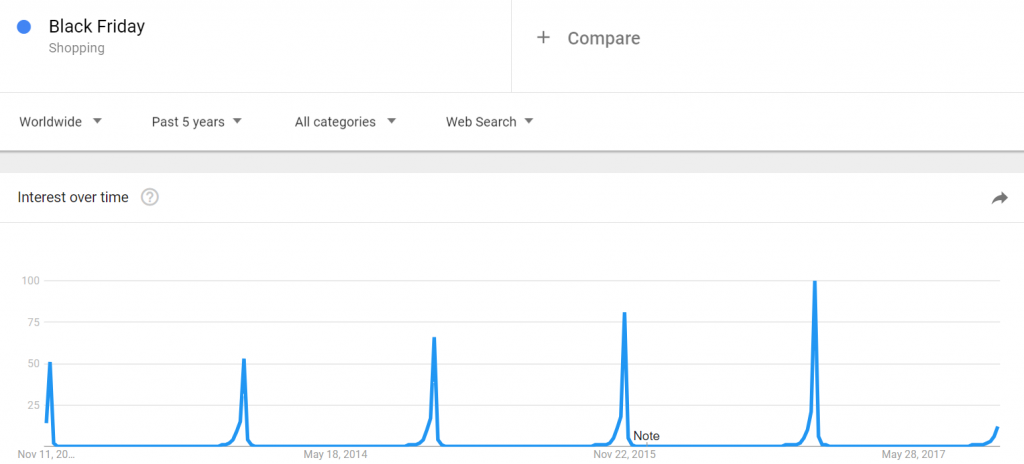
The retailers that make the most of this will have had a Black Friday page in place for years already, which benefits from the backlinks that have been sent to the site every year. Small updates, such as adding the year 2017 into the copy and title tag, will help the page gain relevance for this year’s searches.
Once the holidays pass, update the content to move shoppers to more relevant deals and allow the page to accrue SEO value until next year.
Add new content to cover new SEO opportunities
There are less obvious trends to make use of, too.
Recent analysis of BrightEdge data by Eugene Feygin revealed a very significant increase in the number of rich snippets returned for ecommerce queries over the past year. In fact, the research found that there has been an increase in the number of rich snippets of over 26% within the last five months.
Unsurprisingly, Amazon has benefited to a greater degree than most:
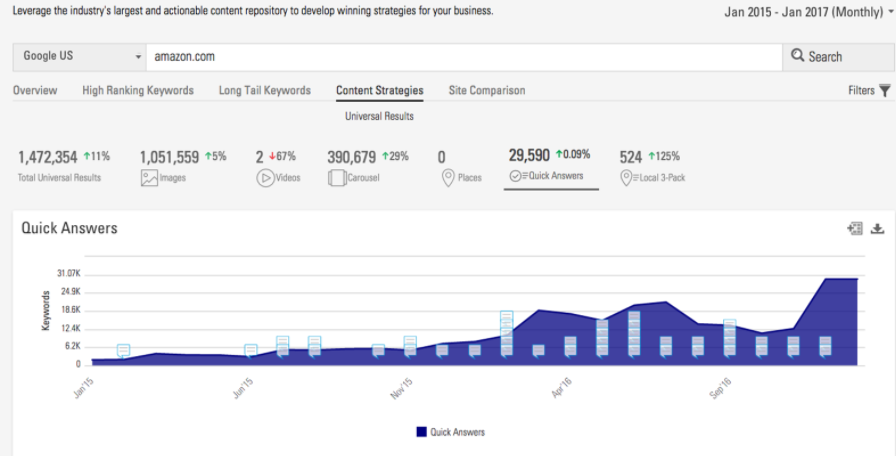
But the same opportunity exists for all retailers.
Given the prominence that is afforded the these quick answers, in what has come to be known as ‘position zero‘, it seems too great a prize to ignore.
The question, then, is how to format content to increase its likelihood of being pulled programmatically as a rich snippet.
There are no black-and-white rules to this, but there are steps we can take to help our chances. For example, using Schema.org mark-up to provide Google with structured data about product features or prices will help greatly, and tools like Moz Keyword Explorer can help identify popular questions.
Repurpose old content to create gift guides
According to Google’s trend report from 2016, more than 70 percent of digital shoppers started their holiday shopping without something particular in mind that they wanted to buy.
The search journey doesn’t end when someone clicks through to a website, of course. With user engagement factors continuing to play a pivotal role in SEO successes, we need to understand the consumer’s intent and match that up to the experience they receive when they land on the site.
Walmart provides a good example of how this can be achieved. They have a range of gift guides, which are categorized by the type of gift the consumer is thinking of, and also for whom they are planning to buy.

It is possible to go further still, through segmentation of content by the consumer’s level of certainty about the product they want to buy. The site can ask these questions to use as prompts to personalize the experience, with live chatbots playing an ever greater role in this area.
This must be complemented by an oft-overlooked aspect of ecommerce SEO: optimization of internal search. A report by Visualsoft found that 17% of UK retailers do not pay attention to the effectiveness of their internal search engine, but this should be taken into account by all ecommerce sites. To do so means making use of autocomplete searches, product recommendations based on search history, and personalized results.
These points require the refinement and adaptation of existing assets for most brands, so they can still be considered quick win activities for the holidays.
Optimize for speed
Back in 2012, Amazon calculated that just one second of slowdown in page load speed costs them $1.6 billion in lost sales, a number that can only have grown in the intervening years.
The aforementioned report from Visualsoft made blunt a point of which we are all aware: when providing a great ecommerce experience, speed matters. It also highlighted how far a lot of online retailers are from meeting the benchmarks expected of them by their customers:
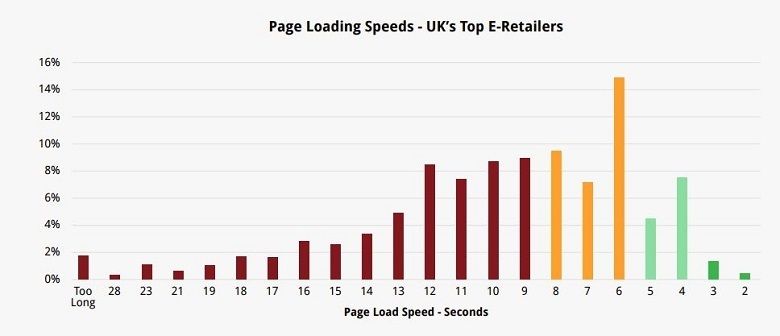
Source: Visualsoft
In addition, new research from BrightEdge (full report here) has highlighted the peak traffic days across devices:
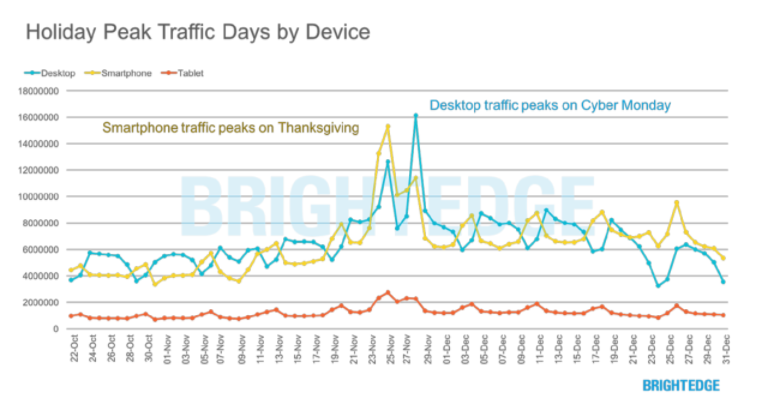
This data shows that while mobile traffic peaks on Thanksgiving, it is desktop that takes the lion’s share of visits on Cyber Monday. Moreover, BrightEdge’s research found that desktop takes 67% of overall conversions in the holiday season, as its traffic converts at a significantly higher rate than mobile visits.
Marketers need to be in prime position to move these consumers through to their intended transaction, as they research on one device and come back to convert on another.
Therefore, if there is only one area of on-site experience that SEOs can contribute towards, it should be page load speed. Improved speed can help rankings directly, but it is also a proven way to improve conversion rates on mobile, desktop, and tablet.
The road to achieving this will depend on the website in question, but some best practices would be:
- Minimize the number of HTTP requests required to load the page
- Reduce the number of redirects needed to arrive at the final URL
- Compress or re-size images.
Optimize mixed media assets
It stands to reason that with so many shoppers seeking inspiration, images and videos are essential components of an SEO strategy for the holidays.
At the last minute, brands are likely to have their media strategies set in stone, but SEO can always help to attract more traffic to these assets.
As such, we should be thinking about optimization for search engines like Pinterest and YouTube, and not just Google and Bing.
That said, Google’s universal results provide an excellent opportunity to draw more traffic if images and videos are optimized for the right queries.
Therefore, SEO research for the holiday season should aim to identify the keyword categories and types for which images and videos are returned in the SERPs. Keyword tools like BrightEdge and SEMrush provide a way to do this at scale, helping marketers to evaluate the best areas to apply their efforts.
Take lessons from other digital marketing channels
With such limited time left to test SEO changes, retailers should look to paid media channels to find quick, substantial lessons to apply to organic search. PPC ad copy can be a goldmine for these insights, as is reveals the triggers most likely to appeal to consumers when they are searching. Take the best-performing ad copy variations from paid search and incorporate these into SEO messaging to draw a higher click-through rate.
Recent research into social media ad performance also found that informal, conversational language works best. People tend to be in a different mindset when on social media compared to search, which is driven by their underlying intent and the different natures of the platforms. However, this tone of voice could still be worth testing within PPC ads to see if it helps brands stand out and connect.
That said, we need to bear in mind that consumers don’t think in terms of SEO, PPC, or social media when they are shopping for gifts. They move between these channels and expect a consistent tone in their interactions with a brand.
SEOs should look to broader consumer surveys to understand the role their channel can play to ensure that this consistency is achieved.
One such study from Astound Commerce asked, “Which of the following will most likely prompt you to visit a retailer online this holiday season?”
Consumers, who were prompted to select all of the responses that applied to them, revealed just how many factors can potentially come into play:
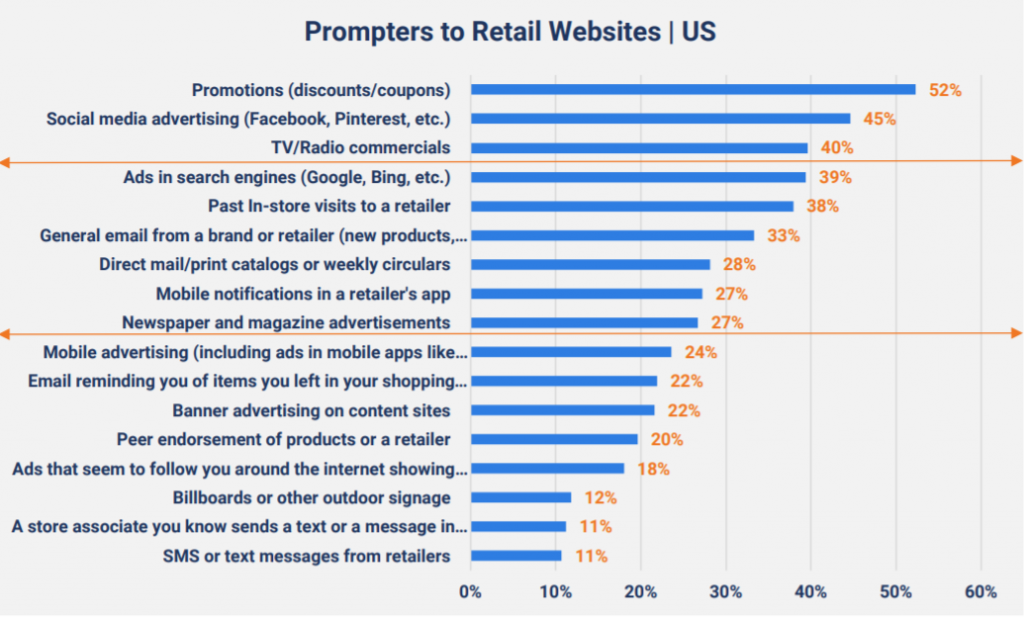
This is a complex set of interconnected communications, but there are a few clear takeaways for SEO. For example, promotions are a key driver of traffic, so we should add any relevant deals into on-page copy and meta tags.
Make sure your servers are ready
The SEO team at any retailer has important responsibilities on the technical side of things over the holidays.
If all goes to plan, there should be a significant surge in the number of visitors to the site over a short period of time, which can play havoc with servers. Downtime is particularly disastrous at this time of year, so take steps to prepare.
It is worth visiting the site’s error logs to see if there is anything you can fix in advance of the traffic increase, and make sure you have a dedicated point of contact on stand-by if any issues should arise over the holiday season.





